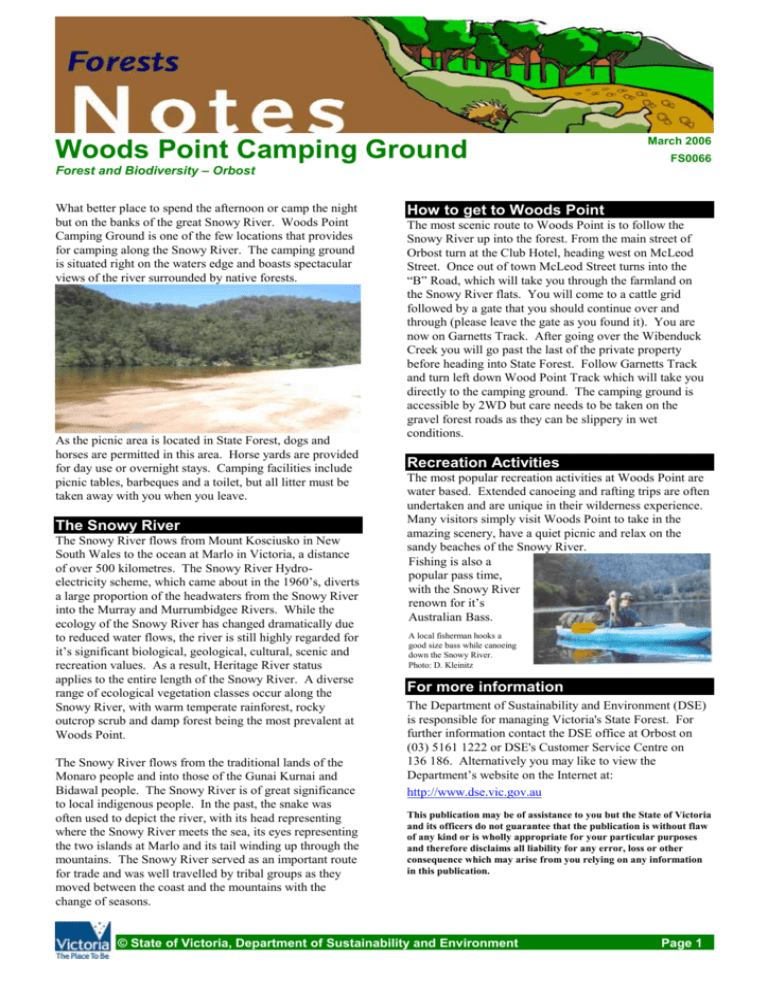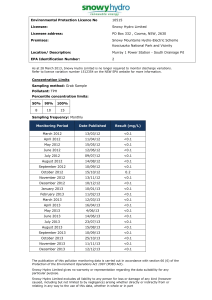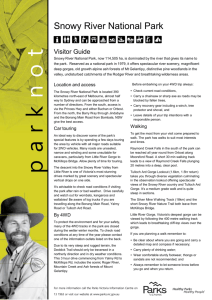Woods Point Camping Ground (accessible version)
advertisement

Woods Point Camping Ground Forest and Biodiversity – Orbost What better place to spend the afternoon or camp the night but on the banks of the great Snowy River. Woods Point Camping Ground is one of the few locations that provides for camping along the Snowy River. The camping ground is situated right on the waters edge and boasts spectacular views of the river surrounded by native forests. As the picnic area is located in State Forest, dogs and horses are permitted in this area. Horse yards are provided for day use or overnight stays. Camping facilities include picnic tables, barbeques and a toilet, but all litter must be taken away with you when you leave. The Snowy River The Snowy River flows from Mount Kosciusko in New South Wales to the ocean at Marlo in Victoria, a distance of over 500 kilometres. The Snowy River Hydroelectricity scheme, which came about in the 1960’s, diverts a large proportion of the headwaters from the Snowy River into the Murray and Murrumbidgee Rivers. While the ecology of the Snowy River has changed dramatically due to reduced water flows, the river is still highly regarded for it’s significant biological, geological, cultural, scenic and recreation values. As a result, Heritage River status applies to the entire length of the Snowy River. A diverse range of ecological vegetation classes occur along the Snowy River, with warm temperate rainforest, rocky outcrop scrub and damp forest being the most prevalent at Woods Point. The Snowy River flows from the traditional lands of the Monaro people and into those of the Gunai Kurnai and Bidawal people. The Snowy River is of great significance to local indigenous people. In the past, the snake was often used to depict the river, with its head representing where the Snowy River meets the sea, its eyes representing the two islands at Marlo and its tail winding up through the mountains. The Snowy River served as an important route for trade and was well travelled by tribal groups as they moved between the coast and the mountains with the change of seasons. March 2006 FS0066 How to get to Woods Point The most scenic route to Woods Point is to follow the Snowy River up into the forest. From the main street of Orbost turn at the Club Hotel, heading west on McLeod Street. Once out of town McLeod Street turns into the “B” Road, which will take you through the farmland on the Snowy River flats. You will come to a cattle grid followed by a gate that you should continue over and through (please leave the gate as you found it). You are now on Garnetts Track. After going over the Wibenduck Creek you will go past the last of the private property before heading into State Forest. Follow Garnetts Track and turn left down Wood Point Track which will take you directly to the camping ground. The camping ground is accessible by 2WD but care needs to be taken on the gravel forest roads as they can be slippery in wet conditions. Recreation Activities The most popular recreation activities at Woods Point are water based. Extended canoeing and rafting trips are often undertaken and are unique in their wilderness experience. Many visitors simply visit Woods Point to take in the amazing scenery, have a quiet picnic and relax on the sandy beaches of the Snowy River. Fishing is also a popular pass time, with the Snowy River renown for it’s Australian Bass. A local fisherman hooks a good size bass while canoeing down the Snowy River. Photo: D. Kleinitz For more information The Department of Sustainability and Environment (DSE) is responsible for managing Victoria's State Forest. For further information contact the DSE office at Orbost on (03) 5161 1222 or DSE's Customer Service Centre on 136 186. Alternatively you may like to view the Department’s website on the Internet at: http://www.dse.vic.gov.au This publication may be of assistance to you but the State of Victoria and its officers do not guarantee that the publication is without flaw of any kind or is wholly appropriate for your particular purposes and therefore disclaims all liability for any error, loss or other consequence which may arise from you relying on any information in this publication. © State of Victoria, Department of Sustainability and Environment Page 1






